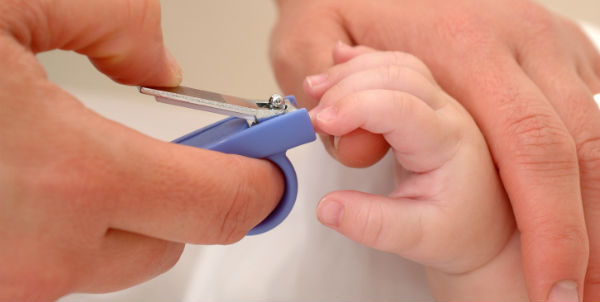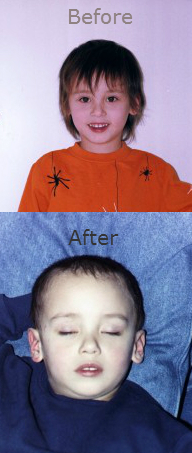
A Special Needs Guide to Haircuts and Fingernail Trimming
 Do you dread the day that your loved one needs to have fingernails trimmed or get a haircut? Do you put it off until the broken nails leave scratch marks and the hair becomes matted?
Do you dread the day that your loved one needs to have fingernails trimmed or get a haircut? Do you put it off until the broken nails leave scratch marks and the hair becomes matted?
If so, you’re not alone. For many families, the word “stressful” doesn’t even begin to describe the danger, meltdowns and panic.
It has taken me years to desensitize my children to routine nail and hair care - now that my kids are 6 and 12 years old, I think I’ve finally figured out what works best for them.
Here are steps that can help make personal grooming a calmer experience for everyone involved.
Safety First
My first rule for personal grooming is to prioritize safety. Make sure that everyone is comfortable in a safe location. Do not sneak up to snip off a lock of hair or do anything to cause surprise. Keep your breathing, voice and movements calm and controlled. If a person is thrashing around in a panic near scissors or nail clippers, it’s time to put the tools away. Try again another day.
Hyperacusis
Hyperacusis is an extreme sensitivity to certain frequencies of sound - for example, the sound of buzzing electric hair clippers. Fortunately, most salons and barbershops now use electric clippers that are almost silent. Some sounds that are not irritating at all to one person may be severely painful for another person to hear, such as the sound of fingernails being cut. If a person appears to be pained by a specific sound, consider using soundproof headphones or noise-canceling headphones during grooming. The Brown family recommends flexible ear plugs in their list of 20 tips for grooming a highly sensitive person.
Phobias
My children are both terrified of having scissors near their faces, even though they have never been harmed. Some people panic at the sight of fingernail clippers. Other people have a phobia of changing their appearance too drastically or losing a part of themselves. All of these fears may be overcome through gradual desensitization.
Keep Tools Visible
Sometimes it helps to leave the tools on the bathroom counter or next to the TV so that they become an everyday sight, and to encourage frequent handling of the tools. One family purchased a professional manicuring kit so that their child could handle and experiment with all of the available tools. The family discovered that the tiny manicuring scissors were less irritating and just as effective as clippers, and the child had more patience for nail trimming.
Find a Hair styling App
For fears of a changing appearance, hairstyle apps for your mobile phone, such as Hairstyle Swap, will allow you to try different hairstyles on yourself before getting a cut. It’s pretty funny when you start adding mustaches and beards, and laughter can be a powerful cure for this phobia.
Use a Social Story
Social stories are an easy step-by-step way to describe expectations of grooming, too. I used the haircut story in the Autism and PDD Primary Social Skills Lesson books published by Linguisystems, and that was a turning point for my older son.
Other reasons for avoidance
Sometimes a person is able to articulate a very good reason for avoiding grooming. Having short, but not too short, fingernails allow a person to scratch an itch in a satisfying way - and this is very important for people who experience tactile sensitivity. A good compromise is to leave one or two fingernails at the proper scratching length.
My older son told me that he is afraid that he might get hurt during grooming, even though he has never actually been hurt. In other cases, the reason is a previous traumatic experience, like a minor cut that happened during nail trimming several years earlier. with fears like these it is necessary to demonstrate the steps that are being taken to avoid injury. Antibiotic sprays with a mild anesthetic can be used before nail trimming to reduce sensation on the fingertips.
Parent modeling
Modeling appropriate behavior during grooming was the single most effective method for teaching my children. I had them sitting on my lap when I got a haircut, and I made sure they saw me trimming my toenails and fingernails - without pressuring them to do the same. We have also been known to groom our stuffed animals, and this gives my children the opportunity to show me how they want to be treated during grooming. Eventually they realized that grooming is a normal everyday activity, and they were not being targeted for torture!
Video modeling
Autism Speaks teamed up with Melmark New England and the national salon chain Snip-Its to produce an instructional video and haircut training guide for families.
Families can also make their own home videos of family members having their hair cut and nails trimmed - even a 30 second video can make a big difference when it becomes part of the family routine. In my family we have used video modeling to normalize all kinds of activities, from gift-opening etiquette to riding roller coasters.
One day at a time
When my children were toddlers, I often resolved to trim just one or two fingernails per day, so that the job would be done within a week. This had the advantage of making grooming literally an everyday occurrence, which made the desensitization process go much more quickly.
I found simple ways of distracting and relaxing my children, such as singing or snuggling them while they watched a favorite DVD. I discovered that counting to 100 in a rhythmic, sing-songy voice had an almost hypnotic effect on my older son, and I usually got all of his fingernails and toenails done before I finished singing. My younger son has told me that watching a video is the only thing that makes toenail trimming tolerable for him.
Keep in mind that fingernails and hair are softest after a bath. Gently pressing on the center of a fingernail just before clipping will temporarily reduce sensitivity.
Some families wait until their loved one is sound asleep, and then trim half or one-third of the hair. I recommend this only for heavy sleepers - my lightly-sleeping children woke up in a panic when I tried it!
Bring in a third person
My children behave in a completely different way with adults who are not their parents. For this reason, I have sought out gentle, flexible stylists to help with haircuts - and the results have been great!
Usually I take my kids to a family salon as soon as it opens in the morning so that there is no waiting time. Immediately after the haircut, I reward my children with a visit to the library or local park. But recently I met a neighbor - a licensed cosmetologist - who will cut children’s hair during playdates at her home, so the playdate is the reward.
Other families have a designated relative or trusted friend who assists with haircuts and nail trimming. Sometimes we just need another person’s fresh outlook to keep the situation positive.
Have a party
Group haircut events are growing in popularity in the special needs community, and they can take place at home, at school or in a therapy clinic. The Autism Collaborative Center at Eastern Michigan University periodically hosts a “Haircut Night” for highly sensitive individuals. At these events, children and adults play in a familiar therapy room while they wait for their appointment with the stylist. A group event relieves some of the tension, because people can watch each other have their hair cut, and they can celebrate their success with each other. Being able to run around and blow off steam before and after the haircut helps, too.
Sedation
When it is impossible to provide routine grooming and medical care, parents and caregivers may request sedation for a loved one. In these extreme cases, a person will have dental cleaning and repair, a medical exam and personal grooming all scheduled for a short time period in a medical clinic.
How do you turn personal grooming into a positive experience? Please share your tips in the comments below.



